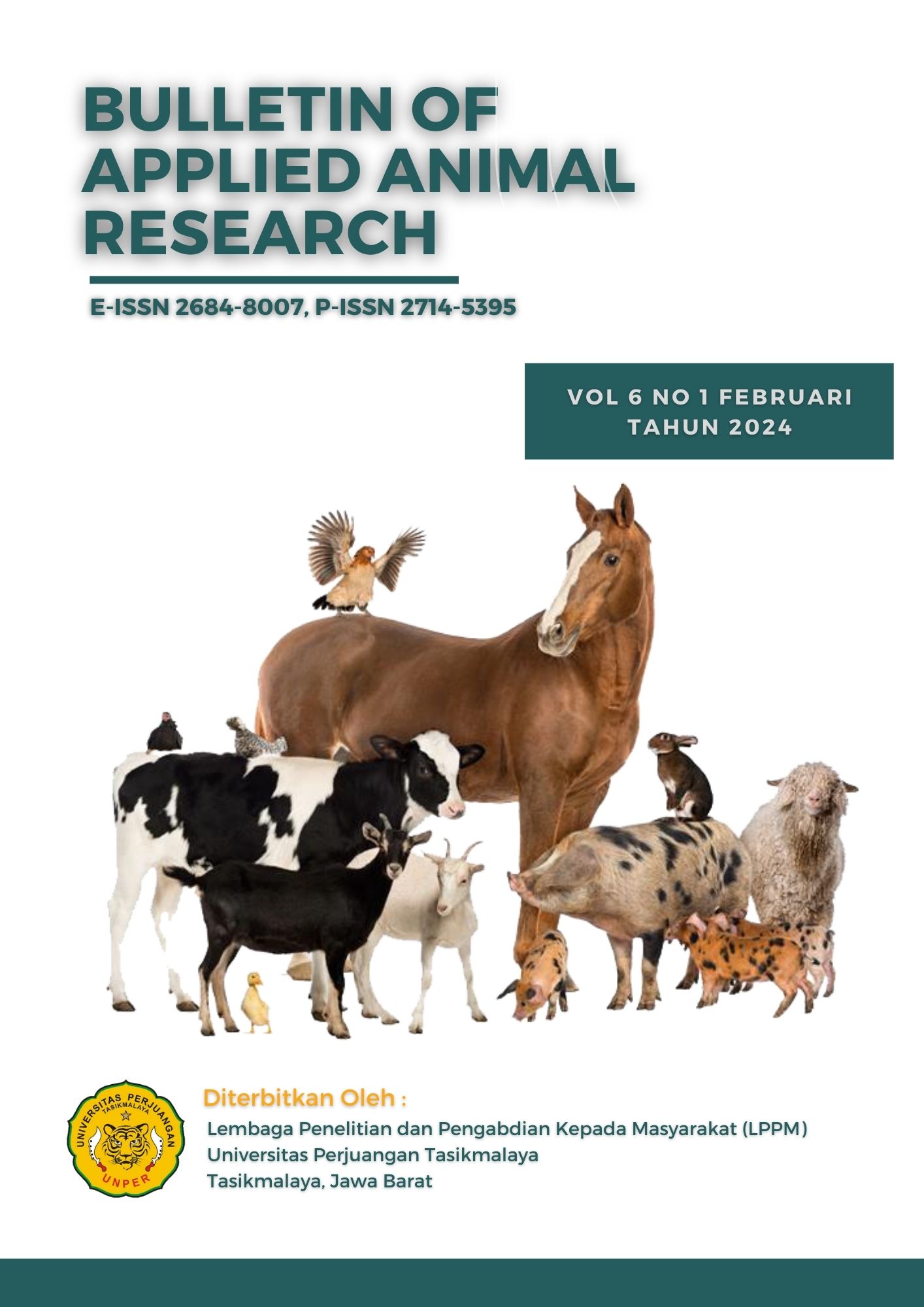Effect of Strain on Feed Conversion Ratio and Broiler Chicken Business Profits
DOI:
https://doi.org/10.36423/baar.v6i1.1374Abstract
The objective of the study was to assess different strains on Feed Conversion Ratio (FCR) and profitability of broiler chicken business. The research was conducted at the farm of PT Berkat Unggas Sehat Sejahtera, Sukabumi, West Java. The method used was historical survey which examined production records according to the variables studied. The variables observed were FCR and business profit. Data were analyzed using descriptive statistics and t test. Broiler strains, Cobb and Ross, were reared in close house cages. The population of each strain was 12,000 birds and reared for 28 days. The results of the study were the average FCR of Cobb strain 1.04 ± 0.29 while Ross strain 0.93 ± 0.26. The profit generated from the Cobb strain was Rp2,859,105.00 while the Ross strain was greater at Rp12,136,043.00. The results of the analysis showed that the strain affected the FCR and profit of broiler chickens. The conclusion of the study is that the Ross strain provides better FCR and profit values compared to the Cobb strain.
References
Abdurofi, I, M.M. Ismail, H.A.W. Kamal, dan B. Gabdo. 2017. Economic analysis of broiler production in Peninsular Malaysia. International Food Research Journal. 24(2):761.
Badan Pusat Statistik. 2022. Populasi Ayam Ras Pedaging Menurut Provinsi (ekor) 2019-2021. Jakarta.
Boki, I. 2020. Pengaruh pakan komersial terfermentasi EM4 terhadap pertambahan bobot badan, konsumsi pakan, dan konversi pakan ayam broiler. Journal of Animal Science. JAS. 5(2):28-30.
Cobb. 2018. Cobb 5000: Panduan Performan Broiler dan Nutrisi. https://www.cobb-vantress.com/assets/Cobb-Files/ (diakses 18 Juni 2023).
Firdausya, A.N., N. Hilmia, dan D. Garnida. 2021. Evaluasi performa produksi telur pada parent stock ayam broiler strain Cobb dan Ross di PT. Charoen Pokphand Jaya Farm Unit Purwakarta. Jurnal Produksi Ternak Terapan. 2(2):39-45.
Gumelar, P.W., dan U. Atmomarsono. 2016. Manajemen Perkandangan Ayam Pembibit Broiler di PT Japfa Comfeed Unit 15 Belik, Desa Kalisaleh Pemalang. Disertasi Doktor. Fakultas Peternakan dan Pertanian UNDIP, Semarang.
Hasan, W., A.H. Salendu, N.M. Santa, dan F.N Oroh. 2018. Analisis keuntungan dan titik impas usaha ternak broiler dengan pola kemitraan (studi kasus di Desa Tetey Kecamatan Dimembe). Zootec, 38(1):235-243.
Irma, S.S., D.K. Taufik dan S. Suparman. 2022. Faktor-faktor yang mempengaruhi keuntungan pada usaha penjualan ayam broiler di Kecamatan Sendana Kabupaten Majene. Maduranch: Jurnal Ilmu Peternakan, 7(1):41-46.
Mulatsih, D.D., 2018. Faktor-faktor yang mempengaruhi keuntungan usahatani ternak ayam broiler di Kabupaten Karanganyar. Agrista, 6(4):20-32.
Murti, A.T., K.S. Suroto dan H. Karamina. 2020. Analisa keuntungan usaha peternakan ayam broiler pola mandiri di Kabupaten Malang (Studi kasus di Kecamatan Karangploso Kabupaten Malang)-Jurnal. SOCA: Jurnal Sosial Ekonomi Pertanian, 14(1):40-54.
Purnama, M.T.E, N. Listyasari dan S. Soeharsono. 2022. Perbedaan performance ayam broiler strain Lohman Broder Mb 202 berdasarkan perbandingan susunan jantan dan betina. Acta VETERINARIA Indonesiana. 10(3).
Rahmaningtyas, I.H., R. Yulianto, D.W. Prastika, K. Arifin, V. Oktaviana, R.S. Setiabudi dan M.T.E. Purnama. 2017. Efektivitas tepung teritip (Cirripedia sp) terhadap pertambahan berat badan dan feed convertion ratio ayam pedaging. J. Agro Veteriner Universitas Airlangga, 5(2).
Sodiq, A., S,A, Santosa, N.A. Setianto, A. Susanto dan N. Hindratiningrum. 2023. Rancangan Penelitian : Penelitian Eksperimental dan analis Data. Unsoed Press
Sultan, S., W. Horhoruw, and M. Wattiheluw. 2023. Performance of broiler raised on the upper and lower floors postal dounle deck cages with semi close house system. Jurnal Agrosilvopasture-Tech. 2(2):248-259. doi: 10.30598/j.agrosilvopasture-tech.2023.2.2.248.
Swarta, S. 2014. Feed Conversion Ratio (FCR) usaha ternak ayam brolier di Kabupaten Sleman. Agrika. 8(2):131.
Downloads
Published
How to Cite
Issue
Section
License
Copyright (c) 2024 Setya Agus Santosa, Cici Rahayu Sariningsih, Elly Tugiyanti

This work is licensed under a Creative Commons Attribution-ShareAlike 4.0 International License.












